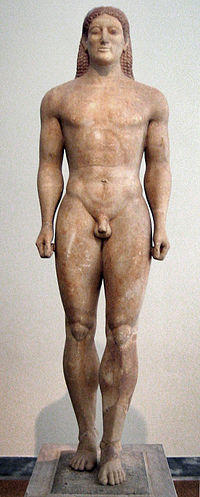The Kroisos Kouros (Ancient Greek: κοῦρος) is a marble kouros from Anavyssos (Ανάβυσσος) in Attica which functioned as a grave marker for a fallen young warrior named Kroisos (Κροῖσος).[1][2]
Overview
The free-standing sculpture strides forward with the "archaic smile" playing slightly on his face. The sculpture is dated to c. 540–515 BC and stands 1.95 meters high.[3] It is now situated in the National Archaeological Museum of Athens (inv. no. 3851).
The inscription on the base of the statue reads:
- ΣΤΕΘΙ ∶ ΚΑΙ ΟΙΚΤΙΡΟΝ ΚΡΟΙΣΟ
- ΠΑΡΑ ΣΕΜΑ ΘΑΝΟΝΤΟΣ ΗΟΝ
- ΠΟΤ’ ΕΝΙ ΠΡΟΜΑΧΟΙΣ ∶ ΟΛΕΣΕ
- ΘΟΡΟΣ ∶ ΑΡΕΣ
"Stop and show pity beside the marker of Kroisos, dead, whom, when he was in the front ranks, raging Ares destroyed".
The Kroisos Kouros is central to two ongoing archeological debates: first, whether kouroi represented specific young men or were generic representations of idealized archetypes which might not actually resemble a specific person commemorated, and thus are symbolic representations embodying the ideal of the male warrior en promáchois (ἐν προμάχοις), "in the front line" of battle, not naturalistic ones; and second the authenticity of the Getty kouros, which bears a falsified provenance and displays a suspicious similarity to the Kroisos kouros.[4]
References
- ^ Fred Kleiner (1 January 2013). Gardner's Art through the Ages: The Western Perspective. Cengage Learning. pp. 113–. ISBN 978-1-133-95481-1.
- ^ The Anavysos Kouros Alex. Philadelpheus The Annual of the British School at Athens Vol. 36, (1935/1936) , pp. 1-4 Published by: British School at Athens Stable URL: https://www.jstor.org/stable/30096873
- ^ Judith M. Barringer (31 December 2014). The Art and Archaeology of Ancient Greece. Cambridge University Press. pp. 334–. ISBN 978-1-139-99174-2.
- ^ Marion True. The Getty Kouros: Background on the Problem, in The Getty Kouros Colloquium, 1993, p. 13.
Further reading
- Nikolaos Kaltsas: Sculpture in the National Archaeological Museum, Athens, The J. Paul Getty Museum, Los Angeles 2002, ISBN 0-89236-686-9, p. 58–59.
External links
 Media related to Kroisos Kouros at Wikimedia Commons
Media related to Kroisos Kouros at Wikimedia Commons- Anavyssos Kouros
